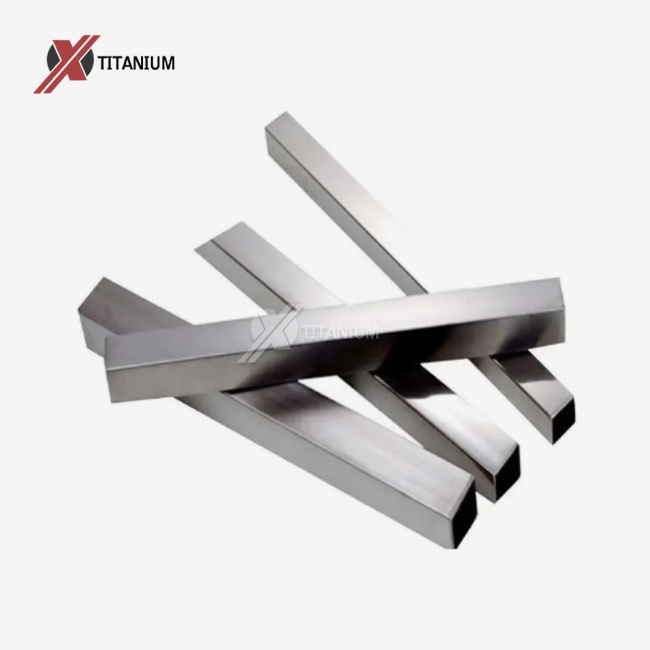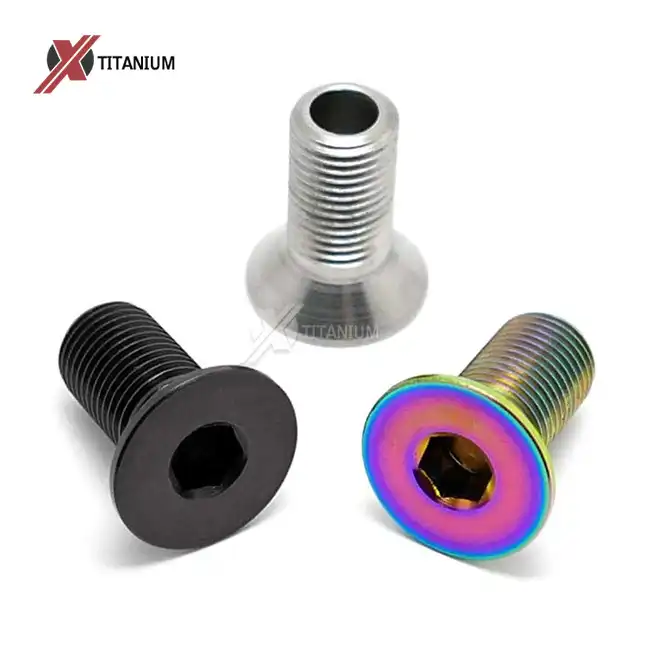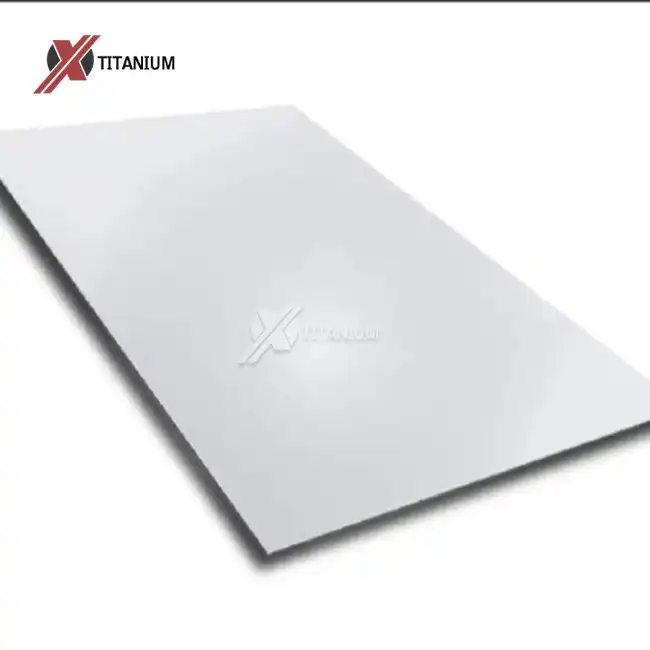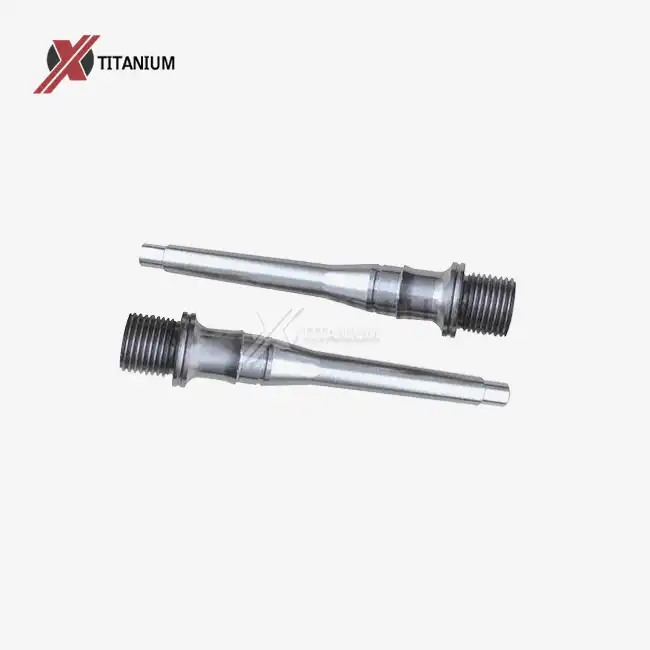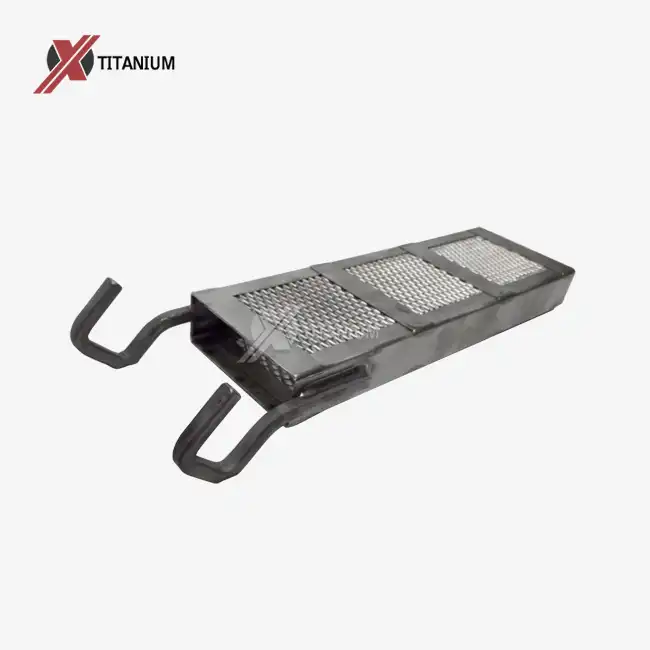The Science Behind Titanium's Strength-to-Weight Advantage
Atomic Structure and Bonding
At the heart of titanium's remarkable strength-to-weight ratio lies its atomic structure. Titanium atoms form a hexagonal close-packed (HCP) crystal structure, which provides excellent strength and stability. This arrangement allows for efficient packing of atoms, contributing to titanium's density of approximately 4.5 g/cm³ - significantly lower than steel's 7.85 g/cm³ but higher than aluminum's 2.7 g/cm³.
The strong covalent bonds between titanium atoms result in high tensile strength and resistance to deformation. These bonds are more robust than those found in steel or aluminum, allowing titanium to maintain its structural integrity under higher stresses relative to its weight. This property is particularly evident in titanium square rod products, which exhibit exceptional strength-to-weight characteristics.
Alloying and Heat Treatment
Titanium's strength can be further enhanced through alloying and heat treatment processes. Common alloying elements include aluminum, vanadium, and molybdenum. These additions can significantly improve the metal's mechanical properties without substantially increasing its weight. For instance, the widely used Ti-6Al-4V alloy (Grade 5 titanium) offers an excellent balance of strength, toughness, and corrosion resistance.
Heat treatment techniques such as solution treating and aging can optimize the microstructure of titanium alloys, leading to even higher strength-to-weight ratios. These processes can be tailored to produce titanium square rod with specific mechanical properties suited for various applications, from aerospace components to medical implants.
Density and Strength Comparison
To truly appreciate titanium's strength-to-weight advantage, let's compare its properties to those of steel and aluminum:
Titanium (Grade 5): - Density: 4.43 g/cm³ - Tensile Strength: 900-1200 MPa - Specific Strength: 203-271 kN·m/kg
Steel (AISI 4340): - Density: 7.85 g/cm³ - Tensile Strength: 745-1950 MPa - Specific Strength: 95-248 kN·m/kg
Aluminum (7075-T6): - Density: 2.81 g/cm³ - Tensile Strength: 572 MPa - Specific Strength: 204 kN·m/kg
These figures demonstrate that while steel can achieve higher absolute strength, titanium's lower density results in a superior strength-to-weight ratio. Aluminum, despite its lightness, cannot match titanium's strength, making titanium square rod an optimal choice for applications requiring both strength and weight savings.
Applications Leveraging Titanium's Strength-to-Weight Ratio
Aerospace and Aviation
The aerospace industry has been a primary beneficiary of titanium's exceptional properties. Aircraft manufacturers utilize titanium alloys extensively in critical components such as landing gear, engine parts, and structural elements. Titanium square rod is often machined into complex shapes for use in these high-performance applications.
In spacecraft design, where every gram matters, titanium's strength-to-weight ratio is invaluable. It allows for the construction of robust structures that can withstand the extreme conditions of space while minimizing launch costs associated with weight.
Automotive Engineering
As the automotive industry strives for improved fuel efficiency and performance, titanium is finding increased use in high-end and racing vehicles. Titanium exhaust systems, suspension components, and connecting rods benefit from the metal's strength and light weight. Titanium square rod suppliers often cater to this market, providing materials for custom automotive parts.
In Formula 1 racing, where performance margins are razor-thin, titanium components give cars a competitive edge by reducing weight without compromising structural integrity. This application showcases the material's ability to excel under extreme conditions.
Medical Implants and Prosthetics
The biomedical field leverages titanium's strength-to-weight ratio in combination with its biocompatibility. Titanium alloys are widely used in orthopedic implants, dental implants, and prosthetic limbs. The low weight of titanium reduces strain on the body while providing the necessary strength to support loads and resist wear.
Titanium square rod is often the starting point for manufacturing these medical devices. Its machinability allows for the creation of custom implants tailored to individual patient needs, while its strength ensures long-term durability in the human body.
Challenges and Innovations in Titanium Production
Extraction and Processing
Despite its abundant presence in the Earth's crust, titanium extraction remains a complex and energy-intensive process. The Kroll process, the primary method for producing titanium metal, involves multiple steps and high temperatures. This complexity contributes to the relatively high cost of titanium compared to steel or aluminum.
Ongoing research aims to develop more efficient extraction methods. Innovations such as the FFC Cambridge process show promise in reducing energy consumption and production costs, potentially making titanium more accessible for a broader range of applications.
Additive Manufacturing and 3D Printing
Additive manufacturing technologies are revolutionizing titanium part production. 3D printing allows for the creation of complex geometries that were previously impossible or impractical to manufacture. This capability is particularly valuable in aerospace and medical applications, where customized, lightweight structures can significantly enhance performance.
Titanium square rod suppliers are adapting to this trend by offering materials specifically formulated for additive manufacturing processes. These specialized powders and wires enable the production of parts with optimized strength-to-weight ratios and tailored mechanical properties.
Surface Treatment and Coatings
While titanium's natural oxide layer provides excellent corrosion resistance, various surface treatments can further enhance its properties. Techniques such as nitriding, carburizing, and the application of ceramic coatings can improve wear resistance, hardness, and even biocompatibility.
These surface modifications allow titanium components to maintain their strength-to-weight advantage while addressing specific performance requirements. For instance, titanium square rod used in marine applications may undergo specialized treatments to withstand saltwater exposure without compromising its mechanical properties.
Conclusion
Titanium's remarkable strength-to-weight ratio sets it apart from steel and aluminum, making it an indispensable material in various high-performance applications. As a trusted titanium square rod supplier, Baoji Chuanglian New Metal Material Co., Ltd. delivers premium solutions designed to meet the rigorous demands of diverse industries. Its unique atomic structure, enhanced by alloying and heat treatment, allows for exceptional strength without excessive weight. From aerospace and automotive engineering to medical implants, titanium continues to push the boundaries of material science.
If you're looking for high-quality titanium square rod or other titanium products, look no further than Baoji Chuanglian New Metal Material Co., Ltd. As a leading titanium square rod supplier, we offer a wide range of titanium products tailored to your specific needs. With over a decade of experience in titanium manufacturing and research, we provide top-notch solutions for industries ranging from aerospace to medical devices. Contact us today at info@cltifastener.com or djy6580@aliyun.com to learn how our titanium expertise can benefit your next project.
FAQ
What makes titanium square rod unique compared to other shapes?
Titanium square rod offers excellent strength and stability in a compact form, making it ideal for applications requiring high load-bearing capacity in limited space. Its shape allows for easy machining and integration into various designs.
How does the corrosion resistance of titanium compare to steel and aluminum?
Titanium exhibits superior corrosion resistance compared to both steel and aluminum, thanks to its naturally forming oxide layer. This makes it particularly suitable for marine and chemical processing applications.
Can titanium square rod be welded or machined easily?
Yes, titanium can be welded and machined, although it requires specific techniques and tools due to its unique properties. Proper handling and processing methods ensure optimal results in fabrication.
References
1. Lutjering, G., & Williams, J. C. (2007). Titanium (2nd ed.). Springer-Verlag Berlin Heidelberg.
2. Peters, M., Kumpfert, J., Ward, C. H., & Leyens, C. (2003). Titanium alloys for aerospace applications. Advanced Engineering Materials, 5(6), 419-427.
3. Rack, H. J., & Qazi, J. I. (2006). Titanium alloys for biomedical applications. Materials Science and Engineering: C, 26(8), 1269-1277.
4. Fray, D. J., Farthing, T. W., & Chen, Z. (1999). Removal of oxygen from metal oxides and solid solutions by electrolysis in a fused salt. WO Patent, 99(64638), 10.
5. Banerjee, D., & Williams, J. C. (2013). Perspectives on titanium science and technology. Acta Materialia, 61(3), 844-879.
